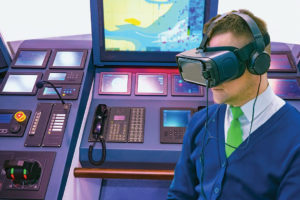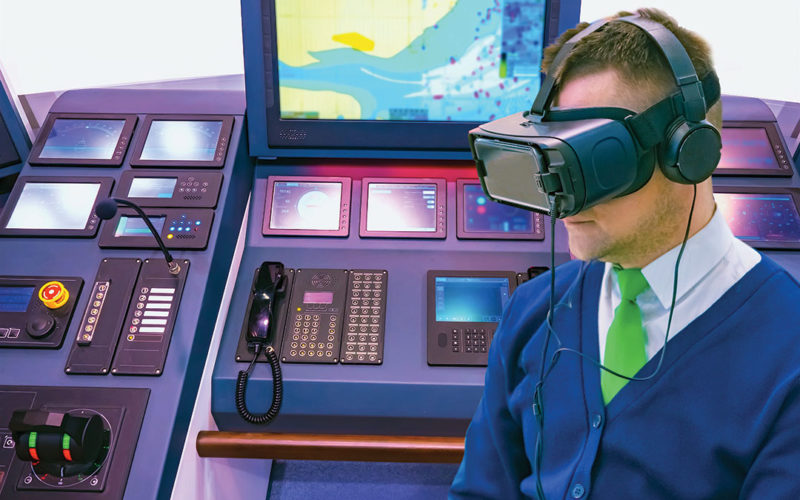An emerging trend before the pandemic, online training has now become a major element in maintaining and improving mariner skills almost everywhere — with consequences that so far seem to be mostly positive.

Ukraine-based Danica Crewing Services recently conducted a broad survey of mariners that included questions about online training. Fifty-three percent of seafarers said they receive some sort of computer-based instruction when they are back home, with the courses generally provided by their company. COVID-19 had little impact; the training did not slacken during the pandemic and may have increased slightly.
According to the Danica report, the use of online training doubled between 2019 and 2020 for European mariners. Sixty-three percent said they found it to be useful, and a remarkable 85 percent of those who used the online training option indicated that it was superior to classroom training they had experienced.
“There are some courses that are perfectly suited to either online or remote delivery and some classes where the training would not be effective in that manner,” said Dave Abrams, CEO of the Training Resources Maritime Institute in San Diego. It’s difficult to simulate via computer the conditions that mariners face when putting out a fire, he noted, and “climbing onto a raft in a survival suit or deploying a lifeboat is not something you want to learn how to do for the first time when your life depends on it.”
One challenge is that many mariners do not have access to the internet while at sea, and some don’t have reliable access at home. “Some mariners don’t even own a computer,” Abrams said. Then there is the issue of different learning styles. Mariners tend to be “hands-on” learners, and “death by PowerPoint” is not the preferred method of conveying knowledge to these students, he said.
“My instructors try to make learning experiential and even entertaining,” Abrams said. “A lot of learning is done through sharing of sea stories, both from the students and instructors. You just don’t get that kind of interaction through an online course. We do offer online courses, but many of those still require the students to take exams or assessments in person.”
Julie Keim, owner of Compass Courses in Edmonds, Wash., said she has resisted online training for years “because I’m a lower-level licensing school and one-on-one instruction is really important for mariners just starting out. I think you get different learning experiences when you have other students in the classroom to network with and talk about their employers or their own personal experience.”
There also can be technological drawbacks with computer-based learning that participants don’t have to face in a traditional classroom setting. “What I have heard from students who have experienced online training is that it has been a fiasco,” Keim said. “It doesn’t work when the instructor moves around, they can’t hear, or the application crashes.”
However, with COVID restrictions, Compass Courses has gone from a typical class size of 24 to just 12. Keim is now thinking about offering some of the basic training modules for personal survival online because it is a refresher and revalidation course. “That makes more sense to me than for a person just getting into the industry,” she said.
Rick Schwab, senior director of the Maritime and Industrial Training Center at Delgado Community College in New Orleans, was faced with a similar rock-and-a-hard-place choice as COVID restrictions affected traditional training. He said the school made the necessary compromises over the past year, investing in equipment to support real-time Zoom classes — not just online or on-demand, but actual interactive classrooms.
Schwab said the U.S. Coast Guard approved the programs on a temporary basis and is reviewing the arrangement quarterly, noting that students still must show up in-person for both testing and “practical” work. And while he is hopeful that some of the investments in remote learning may be applicable to refresher and awareness training, he expects instruction to largely revert to traditional forms once vaccination rates have made COVID a less pressing concern.
But there are those who believe that with the help of advanced technology, mariner training can evolve online to something as good or better than traditional classroom learning. The trend has accelerated during the pandemic, which has forced enterprises to aggressively explore and rapidly adopt remote work and automation solutions to ensure the safety of workers and maintain consistent operations, said Dirck Schou, CEO and co-founder of Seattle-based Taqtile, which develops augmented reality (AR) and virtual reality (VR) technologies.
“Especially in the maritime industry, organizations need solutions (that are) flexible enough to adapt to varied situations as they look to improve the resiliency of maintenance and training at remote locations,” Schou said. He said his company is seeing increased adoption of AR solutions that enable organizations to leverage the knowledge of their workforce experts and share it quickly and efficiently across teams of frontline workers handling complex machinery.
AR-based solutions can allow highly skilled workers to efficiently author step-by-step processes for use in any operational or training capacity aboard their ship, or on any other similarly equipped vessel around the world, Schou said. Other mariners can then follow the procedures to correct equipment issues, ensure configuration control, increase operational availability and improve readiness.
“These solutions are especially valuable for high-complexity maintenance tasks where procedures are long, error-prone, infrequent or require remote assistance,” Schou said. The AR solutions also provide a critical audit and evaluation tool when used during more routine tasks to ensure they are performed consistently and accurately, allowing workers to capture video and photos after key steps in procedures.
Most training providers have switched to some form of online delivery during the pandemic via a Zoom or Teams call where they go through the same material as in a classroom setting, said Kristian Andreasen, CEO of Kanda, a digital consulting organization based in Denmark and Singapore. Since a lot of training in the maritime sector also involves simulator work, that part of the process is often being postponed until it can be done safely in person.
However, Capt. Jon Kjaerulff, director of business development at MITAGS West in Seattle, said remote instruction has grown in importance at the center to the point where simulator training has been extended to those not able to attend in person.
“We had a series last year with the Mexican pilots association that was essentially a Zoom meeting where MITAGS could share its screen with attendees,” Kjaerulff said. “At first they were skeptical, but they had peers from all over and they said it exceeded their expectations. Now we are looking to expand that.”
Andreasen said most training providers are only online now due to necessity and they will revert to in-person instruction once allowed. He said that long-term change will have to come from the customer side — namely shipowners and ship operators.
“In my opinion, I think there is a lot of psychology at play, especially the endowment effect,” Andreasen said. If a training provider invested several million dollars in a physical simulator, then it is very difficult to entertain the thought that the same exercises “can be done on a $800 commercially available VR headset,” he said.
However, Andreasen said he doesn’t believe in a “silver bullet” for training, not even VR. Learning about a procedure and remembering it is about muscle memory and repetition, he noted. The great advantage of VR is that it provides a cheaper option for doing exactly that.
“The user activates their muscle memory as they move about in the simulation, and it is very easy to send a headset home to employees and let them go through it 20 times at their own pace,” he said. Likewise, he feels Zoom is acceptable for quick status checks but not good for real learning.
An engaging online experience for maritime training should be modeled on gaming, where this is already working well, Andreasen said. Games like World of Warcraft, Fortnite and League of Legends have longstanding communities of people collaborating. They also have years of experience on how to communicate and disseminate information between thousands of people on a purely online platform.
“Going forward into this bright new digital future, we should look more to our kids and how they structure their online lives,” he said.
In the long run, mariners are going to drive how course materials are delivered, Abrams said. VR and AR will play a role as the price of that technology comes down, and remote participation in “live” training will be possible. But 20 years from now, “mariners will still come to school for some aspects of their training,” Abrams said.
As far as instruction becoming entirely online and on-demand, Keim said simply that she hoped “it doesn’t go that way.” Schwab expressed a similar sentiment. “As a school we are always looking at new options, but we believe we need to have that real-time learning with real assessments, so we aren’t likely to put things online for ‘anytime’ participation,” he said. •

